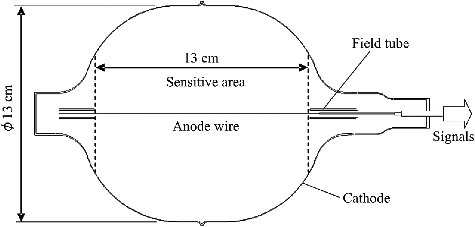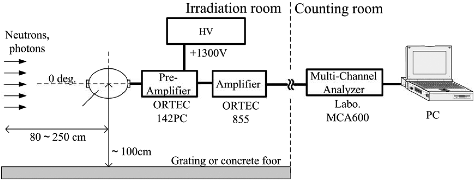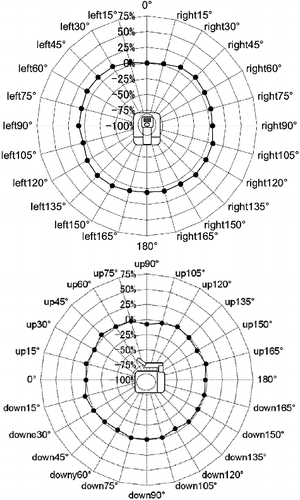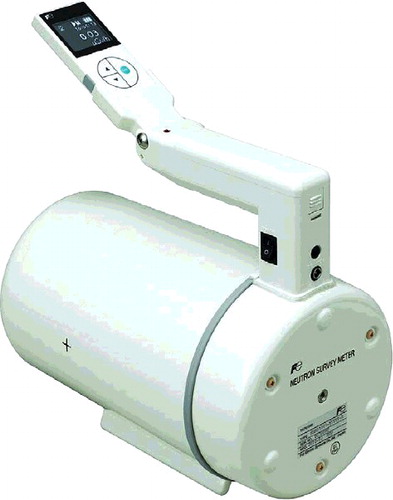 ?Mathematical formulae have been encoded as MathML and are displayed in this HTML version using MathJax in order to improve their display. Uncheck the box to turn MathJax off. This feature requires Javascript. Click on a formula to zoom.
?Mathematical formulae have been encoded as MathML and are displayed in this HTML version using MathJax in order to improve their display. Uncheck the box to turn MathJax off. This feature requires Javascript. Click on a formula to zoom.ABSTRACT
We have developed a lightweight portable neutron survey meter comprising a proportional gas counter containing a mixed gas of methane gas and nitrogen gas for measuring the ambient neutron dose equivalent H*(10) up to about 20 MeV neutrons intended for use in nuclear power plants, and accelerator facilities. Since no heavy polyethylene moderator is used, the survey meter is only about 2.2 kg in weight causing a weight reduction of 70% or more compared to that of the conventional moderated-type survey meter. The spectrum-weight function, G(E) is adopted for dose conversion.
In order to evaluate the energy characteristics of the developed survey meter, mono-energetic neutron reference fields and continuous energy neutron reference fields were used. The evaluation was also carried out by the PHITS calculation. Although the neutron energy response to the mono-energetic neutron fields was highly deviated from the ambient dose equivalent H*(10) in keV energy region, the response to H*(10) showed very good agreement only within 25% to the continuous energy neutron fields which are close to the actual work-place neutron fields. The neutron energy response was also investigated for high energy quasi-mono-energetic neutron fields and showed much better results compared with those of conventional moderated-type neutron survey meters.
1. Introduction
Portable neutron survey meters are widely used in nuclear facilities; however they have generally heavy weight of about 7–11 kg [Citation1]. It is because in those conventional neutron survey meters, a central thermal neutron detector, such as a 3He counter, BF3 counter, and LiI(Tl) scintillator, is covered with thick (about 10 cm) polyethylene moderator. It is therefore quite inconvenient for a person who walks around a large site to survey the neutron dose level by carrying the heavyweight survey meter. Further, the recent shortage of 3He gas supply, so-called 3He crisis, has been a worldwide serious problem in neutron measurement field since the 3He counter has mostly been popular as a central thermal neutron detector due to higher thermal neutron sensitivity [Citation2,Citation3].
Considering these circumferences, we have newly developed a lightweight neutron survey meter which comprises a gas counter containing methane gas and nitrogen gas for dose management in nuclear power plants and accelerator facilities. The developed survey meter, NSN3, is approximately 16 cm × 25 cm × 29 cm in size, and is capable of measuring ambient neutron dose equivalent H*(10) directly from thermal to about 20 MeV neutrons. Since the survey meter comprises no heavy polyethylene moderator, the survey meter is now approximately 2.2 kg in weight, thereby achieving a weight reduction of 70% or more compared to that of the conventional moderated-type neutron survey meters.
The characteristics of this developed neutron survey meter including neutron energy response, angular dependence, and detection efficiency were evaluated using mono-energetic neutron reference fields, continuous energy neutron reference fields, and quasi-mono-energetic neutron reference fields from thermal energy up to 244 MeV. The neutron energy response of the survey meter was also evaluated by calculation using the Particle and Heavy Ion Transport Code System (PHITS) Monte Carlo code [Citation4]. According to the calculated results, the obtained spectrum-weight function, G(E) [Citation5], was used to estimate a better energy response in actual work-place neutron field. This is the first trial to introduce the G(E) function in neutron dose evaluation.
2. Neutron detector
2.1. Outline of neutron detector
The neutron detector is a gas counter containing methane gas of approximately 0.4 MPa and nitrogen gas of approximately 0.1 MPa which are encapsulated in a thin stainless steel vessel as shown in . It is almost a spherical shape having approximately 13 cm in diameter and 13 cm in effective length. The effective volume is approximately 1440 cm3.
The neutrons are measured using the mixed gas of methane and nitrogen. Fast neutrons above several hundreds keV are measured using the elastic scattering reaction of hydrogen H(n, n)p in the methane gas, and slow neutrons including thermal neutrons are measured using the 14N(n, p)14C reaction of nitrogen gas. The thermal neutron cross section of 14N(n, p)14C is about 2 barn, that is one-thousandth smaller than the 3He(n, p)T reaction cross section which is about 5300 barn and the 10B(n, α)7Li reaction cross section which is about 3800 barn. Since the cross sections of 3He and BF3 gases are too higher than the H(n, n)p cross section, the gas pressure of these gases shall be kept less than 50 Pa against the methane gas of 0.4 MPa for realizing good energy response over the wide range, which is very difficult to achieve the accuracy of gas filling.
The proton energy obtained in the 14N(n, p)14C reaction is 626 keV. The electrical pulses are generated from those protons obtained from 14N(n, p)14C and H(n, n)p reactions. Thereby, the neutron ambient dose equivalent can be obtained from thermal to about 20 MeV neutrons. For higher energy region, carbon reactions, such as 12C(n, p) and 12C(n, α) reactions, have some contribution to the output pulses.
2.2. Evaluation of neutron and gamma-ray characteristics
The neutron energy response and detection efficiency at the continuous energy neutron reference fields and the monoenergetic neutron fields were measured at the National Institute of Advanced Industrial Science and Technology (AIST) [Citation6], the Facility of Radiation Standards [Citation7–12] of Japan Atomic Energy Agency (JAEA), the Fast Neutron Laboratory (FNL) [Citation13], and the Cyclotron and Radioisotope Center [Citation14] of Tohoku University. The fluence-averaged neutron energies at various neutron reference fields are shown in for continuous energy neutron fields and for monoenergetic neutron fields. A graphite pile of 150 cm × 164 cm × 150 cm loading a 252Cf source set at the center of the graphite pile [Citation7] is used for both a thermal neutron field and a graphite-moderated neutron field [Citation12]. The graphite-moderated neutron field is produced by using an 241Am–Be source at the shallow position with the thermal neutron rejection sheet made of gadolinium. A concrete-moderated neutron field is a neutron field where the 241Am–Be source is transmitted through concrete blocks of 1 m width, 2.85 m length, and 1 m height [Citation7]. The neutron detector is fixed at 53 cm height from the floor in space, and the neutron spectrum can be changed by keeping a distance of 60, 110, and 160 cm between the source and the concrete blocks. These two neutron fields have wide-spread neutron spectra simulating work-place neutron fields.
Table 1. Fluence-averaged neutron energy of continuous energy neutrons.
Table 2. Fluence-averaged neutron energy of monoenergetic neutrons.
The detector was located at a distance of 80–250 cm from the neutron source. In thermal neutron irradiation at JAEA, the detector was located at a closer distance of 40 cm from the graphite pile surface. The room-scattered neutrons excluding the thermal neutron field were subtracted with the shadow corn method.
Angular distribution was measured using a continuous energy neutron source of 241Am–Be in 15-degree step from 0 to 180 degrees. The detector was located at a distance of 150 cm from the neutron source and of about 100 cm from the concrete floor. The room-scattered neutrons were included in this measurement.
The influence of gamma rays was measured using 137Cs and 60Co sources at 1 and 10 mSv h−1 at Fuji Electric Co. Ltd.
3. Experimental set-up
shows the experimental arrangement. Signals from the neutron detector operated under a supply voltage of +1300 V were fed into a pre-amplifier, ORTEC 142PC, and an amplifier, ORTEC 855, then fed into a multi-channel analyzer, MCA600 (Laboratory Equipment Corporation). Since the rise time of electrical pulses caused by gamma rays is longer than the electrical pulses caused by neutrons, the gamma-ray events are possible to be separated from the neutron event by optimizing the pulse-shaping time constant of the amplifier. In order to suppress the sensitivity to gamma rays, the shaping time constant of the amplifier was set to 0.5 uμs.
4. Revision of neutron dose equivalent using spectrum-weight G-function method
This neutron detector has a disadvantage for measuring neutron energy response between 10 eV and 400 keV because the reaction cross section of 14N(n, p) reaction is very small in this energy region and it has no polyethylene moderator surrounding the neutron detector to thermalize the neutrons. Therefore, the fluence-to-ambient-dose-equivalent conversion coefficient installed in this detector was modified by using the spectrum-weight G-function method. This G-function method is widely adopted for the gamma-ray survey meter to improve the gamma-ray energy response [Citation5,Citation15], and this method is introduced for a neutron survey meter for the first time in this paper. The G-function method we adopted is explained as follows:
The neutron ambient dose equivalent, H*(10), is given by
(1)
(1) where E is an incident neutron energy, h(E) is the fluence-to-ambient-dose-equivalent conversion coefficient, in Sv cm2 which is given by ICRP publication 74 [Citation16], and φ(E) is the neutron energy spectrum in cm−2. The spectrum-weight function, the so-called G-function, is then given by
(2)
(2) where L is the deposition energy in the neutron detector, R(E, L) is the response function per neutron in count cm2 , and G(L) is the correction factor corresponding to L.
The measured pulse height distribution, P(L), is given by
(3)
(3)
By combining EquationEquations (1)(1)
(1) and Equation(2)
(2)
(2) , H*(10) can be obtained from the pulse height distribution, P(L), using the G-function, G(L), as follows:
(4)
(4)
The energy response in the keV energy range is very low compared to h(E) due to the reaction valley of 14N(n, p) and H(n, n)p reactions. In order to increase the neutron energy response in the energy region below several hundreds keV, a modified G-function, G’(L) was obtained by using the appropriately guessed neutron spectrum below 1 MeV. It is known that in most radiation fields at work-places and surrounding environments of nuclear and accelerator facilities, the neutron energy spectra have a similar shape with almost constant neutron fluence per lethargy, that is 1/E spectrum, in the region below 1 MeV [Citation17–19]. This is because nearly all neutrons below 1 MeV result from deceleration due to interaction of neutrons above 1 MeV with matter of light elements such as air, concrete, soil, and the like. The number of neutrons below 1 MeV increases due to the interaction of neutrons above 1 MeV with light elements and then both the numbers are proportional to each other. From this consideration, it is possible to correct the number of neutrons below several hundreds keV from the number of neutrons above 1 MeV. Thus, the modified G-function, G’(L), is used to correct the dose equivalent for neutrons below 400 keV from the information on neutrons around 2 MeV. Here in this study, the neutron energy regions for dose equivalent correction are subdivided between 10 and 400 keV, 800 keV and 1.6 MeV.
The neutron dose equivalent H*(10) can be represented in general by EquationEquation (5)(5)
(5) as follows:
(5)
(5)
This equation can be subdivided as follows:
(6)
(6) where the first term of EquationEquation (6)
(6)
(6) is approximated to be expressed by the following equation:
(7)
(7)
This utilizes the fact that protons produced from the nitrogen reaction 14N(n, p) with thermal neutrons have an energy deposition of 626 keV in the counter. The second term of EquationEquation 6(6)
(6) is approximated to be expressed by the following equation, because lower energy neutrons are produced from the deceleration of higher energy neutrons as described above:
(8)
(8)
The third term of EquationEquation 6(6)
(6) is expressed by the following equation:
(9)
(9)
The neutron dose equivalent H*(10) can be finally represented as follows:
(10)
(10)
This equation can be modified to obtain the following equation:
(11)
(11)
The original G-function, G(L) obtained by unfolding of EquationEquation (4)(4)
(4) shown in is compared with the modified G-function, G’(L) in order to fit the detector response both in the thermal energy region and low energy region between 10 eV and 400 keV to the fluence-to-ambient dose equivalent conversion coefficients given by the ICRP Pub. 74 [Citation16]. The G’(L) values were determined as simply as possible to decrease the influence on them due to the fluctuation of the amplifier built in the detector.
Figure 3. Original G-function, G(L), and modified G-function, G′(L) obtained from EquationEquations (4)(4)
(4) and Equation(11)
(11)
(11) , respectively.
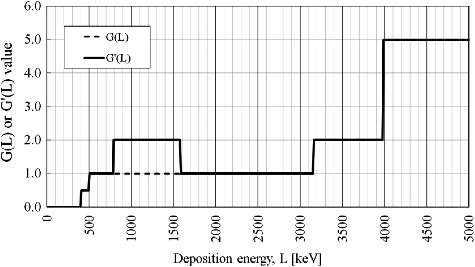
5. Neutron energy response calculation using the PHITS Monte Carlo code
Neutron energy responses were calculated using the PHITS Monte Carlo Code Version 2.64 [Citation4] with JENDL 4.0 [Citation20] neutron cross section data. Neutron energy spectra were obtained in the sensitive area by using the neutron energy from 0.001 eV to 100 MeV which is divided by 10 energy regions in the log-scale at every digit. Neutron energy responses are obtained by summing up the counts above the discrimination level after the correction of the G’(E) function for each incident neutron spectrum. The neutron energy responses were normalized at 2 MeV to obtain the relative neutron response.
6. Results and discussion
6.1. Pulse height distributions
Examples of the detector pulse height distributions are shown in when 1 and 2 MeV monoenergetic neutrons at the FNL of Tohoku University and the thermal neutrons from the graphite pile with 252Cf at the JAEA were irradiated as well as the calculated results using the PHITS Monte Carlo Code are also shown. The peak component around 626 keV for thermal neutron irradiation is due to the protons generated from the 14N(n, p)14C reaction with thermal neutrons. Because of the poor energy resolution of its gas counter, the measured spectra (solid line) are expanded much wider than the calculated spectra (dashed line). The pulse height distributions for 1 and 2 MeV monoenergetic neutrons are due to recoil protons and the edge at the high energy end corresponds to the maximum irradiated neutron energies. The high energy end of the measured data is higher than the irradiated neutron energies. This is also due to the poor energy resolution. The rather short shaping time constant fixed at 0.5 uμs, as described above, can be one of the reasons of the poor energy resolution. The pulse height distributions in the lower energy regions are therefore also shifted to lower values than the calculated values.
Figure 4. Comparison of measured pulse height distributions when thermal neutrons from graphite pile at JAEA, 1 and 2 MeV monoenergetic neutrons at Tohoku University were irradiated along with PHITS calculated results.
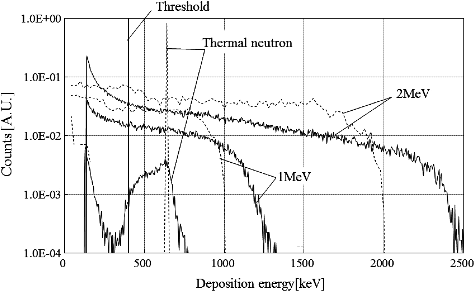
The pulse height distributions are shown in when gamma rays from 137Cs and 60Co sources were irradiated at Fuji Electric Co. Ltd. The irradiated gamma-ray dose equivalent rates were 1 and 10 mSv h−1, respectively. The maximum pulse height of gamma rays from 60Co source is almost the same compared with that from 137Cs source at the same dose rate, despite the different photon energy. The maximum pulse height was around 300 keV when the dose rate was 1 mSv h−1, which is the same pulse height level at natural background dose rate. On the other hand, when the dose rate was 10 mSv h−1, the maximum pulse height was 350 keV. Considering this result, the threshold level of gamma-ray cutoff of this detector was decided at 400 keV in order to suppress the gamma-ray response. This threshold level was determined to decrease the gamma-ray event pulses irradiated at 10 mSv h−1 of 137Cs gamma rays below 0.1%. Neutron events can be determined by summing up the counts above the thus-determined threshold level of 400 keV. The detector response for photon radiations is shown in , which is under 0.1% both at 1 and 10 mSv h−1. It is found that the developed neutron survey meter has almost no response for photon radiation of dose rate below 10 mSv h−1.
Figure 5. Pulse height distributions when gamma rays from 137Cs and 60Co sources were irradiated at Fuji Electric Co. Ltd.
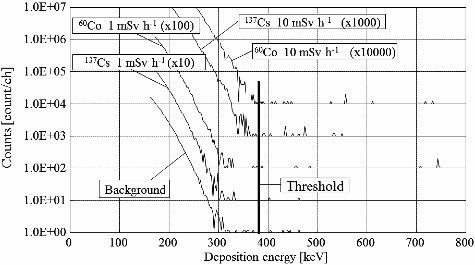
Table 3. Response for photon radiations.
6.2. Neutron energy response
The neutron energy response for neutron fluence was obtained by summing up the counts above the discrimination level of 400 keV. The errors were estimated from the statistical errors of the detector total counts, the neutron fluence at the reference field, and the uncertainties of source intensities. Statistical errors of the total counts were usually less than 3.5% (2σ : σ is the standard deviation); however, in the cases of 144 and 250 keV monoenergetic neutrons, the statistical errors were more than 95% due to the low neutron sensitivity in the energy around 100 keV. Uncertainties of neutron fluence of 252Cf, 241Am–Be sources, and graphite-moderated neutrons were expected to be less than 14% (2σ). Uncertainties of concrete-moderated neutrons were about 20% (2σ). In , the thus-obtained neutron energy responses are indicated by open circles as compared with the fluence-to-ambient-dose-equivalent conversion coefficient curve indicated by a broken line, h*(10), given by the ICRP Pub. 74. The calculated results using the PHITS Monte Carlo code are also indicated by a solid line.
Figure 6. Neutron energy response for neutron fluence of the developed neutron detector. Measured data are open circle, calculated data using PHITS code are solid line of the histogram. Broken line is the fluence-to-ambient-dose-equivalent conversion coefficient, h*(10), given by the ICRP Pub. 74.
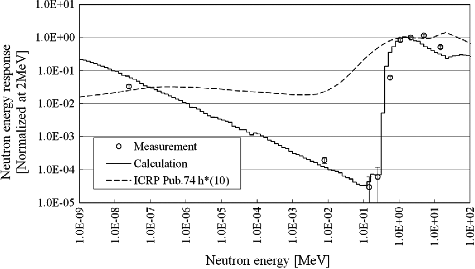
Although the neutron energy response at thermal energy and between 1 and 10 MeV gives good agreement with h*(10), the high-energy neutron response at 14.8 MeV gives underestimated value which is approximately 40% of h*(10). The following causes are conceivable: the neutron elastic scattering reaction cross section with the hydrogen decreases and also the energy deposition of recoil protons decreases, due to the decrease of the stopping power of protons with energy, the energy applied in the detector is reduced, and the obtained signals exceeding the discrimination level of 400 keV are decreased.
The neutron energy responses of 8, 144, and 250 keV give largely underestimated values under 1% with respect to h*(10). This is because the cross section values of 14N(n, p)14C reaction decrease in proportion to the neutron energy and the energy deposition of recoil protons cannot exceed the discrimination level.
While on the other hand, the neutron energy distribution in the actual neutron fields at various work-places and in the surrounding environment have extremely wide-spread energy distribution as described above, and it is strongly required that the neutron energy response shall be investigated in various continuous energy neutron fields simulating real work-place neutron fields. In , the neutron ambient dose equivalent response measured for various continuous energy neutron fields given in are shown, as response values relative to that for 252Cf source as a function of fluence-averaged neutron energy. As a result, it is found that the developed neutron survey meter has sufficiently good response, within 25% difference to neutron ambient dose equivalent for fluence-averaged neutron energy between 0.025 eV and 4.16 MeV having continuous neutron energies.
Figure 7. Neutron ambient dose equivalent response of the developed neutron detector for various continuous energy neutron fields.
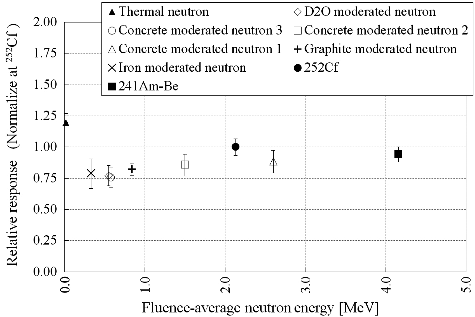
The counting efficiency of this survey meter was obtained to be 0.3 s−1 for 1 μSv h−1 of 252Cf neutron source.
6.3. Angular distribution
Angular distribution was obtained using an 241Am–Be neutron source in every 15-degree from 0 to 180 degrees in the vertical and horizontal directions at Fuji Electric Co. Ltd. The distance between the detector and the neutron source was 40 cm. shows the angular distribution of the developed neutron detector with the statistical error of about 10% (2σ). These are normalized at zero degree of which the direction is shown in . The angular distribution of the detector is almost constant within 15%, because the sensitive area of this detector is almost a spherical shape as shown in . It is found that this developed neutron detector has a flat angular distribution for neutrons in all directions.
7. Fabrication of lightweight neutron survey meter, NSN3
7.1. Specification of NSN3
Based on these experimental studies, we have developed a commercially available lightweight neutron survey meter comprising a gas counter containing methane gas and nitrogen gas for dose management in nuclear power plants and accelerator facilities. This survey meter shown in is capable of directly measuring the ambient neutron dose equivalent H*(10) from thermal to about 20 MeV neutrons. This new neutron survey meter, without a heavy polyethylene moderator, is over 70% lighter than the conventional moderated-type survey meter, NSN1 and NSN2, which are about 7 kg. The specification of this neutron survey meter, NSN3, is shown in .
Table 4. Specifications of neutron survey meter, NSN3.
7.2. Further application of NSN3 to higher energy region
Although the NSN3 survey meter is originally aimed to measure the ambient neutron dose equivalent up to 20 MeV, we further investigated the neutron energy response of NSN3 for higher energy region above 100 MeV for use in high energy accelerator facilities. For this application, the neutron detection efficiency was investigated by measurements at quasi-mono-energetic neutron reference fields of 134, 197, and 244 MeV produced from the 7Li(p, n) reaction at the Research Center for Nuclear Physics (RCNP) cyclotron facility of Osaka University [Citation21]. The results are shown in and , compared with other neutron survey meters [Citation22]. Our new lightweight survey meter, NSN3, shows that neutron responses are in good agreement against the ambient neutron dose equivalent within 35% with respect to the energy region of 100–250 MeV, which is much better than the conventional moderated-type neutron survey meters. In , Fuji Electric NSN1 and Alnor 2202D which are both polyethylene moderated-type give about one-fifth lower values, while on the other hand, WENDI, which is polyethylene and tungsten moderated-type for higher energy use, gives about 30%–60% higher values.
Table 5. Neutron dose equivalent response for quasi-monoenergetic neutrons at RCNP of Osaka University [Citation21, Citation22].
Figure 10. Comparison of neutron dose equivalent responses of four survey meters for quasi-monoenergetic neutrons at RCNP of Osaka University [Citation21, Citation22].
![Figure 10. Comparison of neutron dose equivalent responses of four survey meters for quasi-monoenergetic neutrons at RCNP of Osaka University [Citation21, Citation22].](/cms/asset/7fdb84f5-3641-4c88-8d43-248b9de8e8f8/tnst_a_1359115_f0010_b.gif)
From this measurement, it was clarified that the NSN3 has good quality for measuring the ambient neutron dose equivalent over wide energy range and can be used in various neutron facilities at nuclear power plants, accelerator facilities, and so on.
8. Conclusion
The lightweight portable neutron survey meter, without a polyethylene moderator, comprising a proportional gas counter containing a mixed gas of methane gas and nitrogen gas has been developed. Performance tests were carried out using continuous energy neutron sources using 252Cf and 241Am–Be at JAEA in Japan. The neutron energy responses were obtained from thermal energy to fluence-averaged neutron energy of 4.16 MeV within 25% difference to neutron ambient dose equivalent. Neutron detection efficiency for 252Cf source was obtained to be 0.3 s−1 /(μSv h−1). This neutron detector response is well fitted to the ambient dose equivalent for continuous energy neutron fields reproduced the neutron fields in the actual work-place and its surrounding environmental fields. Further, since the survey meter has excellent sensitivity up to about 250 MeV neutrons, whereas the conventional moderated-type ones have not so much, the developed survey meter is clearly a useful monitoring tool in high energy accelerator facilities. Furthermore, the developed survey meter has very low sensitivity to photons, less than 0.1% for 10 mSv h−1 dose rates.
The neutron detection efficiency of 0.3 s−1/ (μSv h−1) of this lightweight NSN3 survey meter has almost the same efficiency as Alnor 2202D (about 10 kg in weight), although it is lower than 4.0 s−1 /(μSv h−1) of high sensitivity survey meter, NSN1 and NSN2 having 7 kg weight.
It can be finally concluded that this lightweight portable neutron survey meter of 2.2 kg is convenient not only for easy handling of the meter but also for environmental monitoring around nuclear power plants and accelerator facilities.
Acknowledgments
The authors wish to thank the members of the AIST, JAEA, and Tohoku University for their great support during the neutron irradiation.
Disclosure statement
No potential conflict of interest was reported by the authors.
References
- Nakamura T, Hara A, Suzuki T. Realization of a high sensitivity neutron rem counter. Nucl Instrum Methods A. 1985;241:554–560.
- Kouzes RT. The He supply problem. PNNL-18388, Pasific Northwest National Laboratory, Richland, WA, 2009.
- Kouzes RT, Ely JH, Erikson LE, et al. Neutron detection alternatives to 3He for national security applications. Nucl Instrum Methods A. 2010;623:1035–1045.
- Sato T, Niita K, Matsuda N, et al. Particle and heavy ion transport code system PHITS, version 2.52. J Nucl Sci Technol. 2013;50(9):913–923.
- Moriuchi S, Miyanaga I. A spectrometric method for measurement of low-level gamma exposure dose. Health Physics. 1966;12:541–551.
- WWW home page of Neutron Standard Group [Internet]. National institute of advanced industrial science and technology, National Metrology Institute of Japan; [cited 7 Aug. 2017]. Available from: https://unit.aist.go.jp/rima/ract-neu/neutron/english/newhp-e.html
- Yoshizawa M, Saegusa J, Tanimura Y, et al. Calibration fields using RI neutron sources at facility of radiation standards of JAERI. Japan Atmic Energy Agency, JAERI-Conf (2013-002). Japanese.
- Kowatari M, Fujii K, Takahashi M, et al. Evaluation of the characteristics of the neutron reference field using D2O-moderated 252Cf source. Radiat Protec Dosim. 2007;126(1–4):138–144.
- Tanimura Y, Saegusa J, Shikaze Y, et al. Construction of monoenergetic neutron calibration fields using 45Sc(p, n)45Ti reaction at JAEA. Radiat Protec Dosim. 2007;126(1–4):8–12.
- Tanimura Y, Yoshizawa M, Saegusa J, et al. Construction of 144, 565 keV and 5.0 MeV monoenergetic neutron calibration fields at JAERI. Radiat Protec Dosim. 2004;110(1–4):85–89.
- Shikaze Y, Tanimura Y, Saegusa Y, et al. Development of the neutron calibration fields using accelerators at FRS and TIARA of JAEA. J Nucl Sci Technol. 2008;45:209–212.
- Nishino S, Tanimura Y, Ebata Y, et al. Development of the graphite-moderated neutron calibration fields using 241Am–Be sources in JAEA-FRS. 2015. J Radiat Protec Reserch. 2016;41:211–215.
- Baba M, Takada M, Iwasaki T, et al. Development of monoenergetic neutron calibration fields between 8 keV and 15 MeV. Nucl Instrum Methods A. 1996;376:115–123.
- Nakamura T, Ohkubo T, Uwamino Y, et al. Development of simple neutron reference calibration field and its evaluation, INS-T-453. The University of Tokyo; 1986. Japanese.
- Sato T, Satoh D, Endo A, et al. Development of dose monitoring system applicable to various radiations with wide energy range. J Nucl Sci Technol. 2005;42(9):768–778.
- Conversion coefficients for use in radiological protection against external radiation, International Commission on Radiological Protection. ICRP publication 74. Oxford: Elsevier Science; 1995.
- Nakamura T, Nunomiya T, Abe S, et al. Sequential measurements of cosmic-ray neutron spectrum and dose rate at sea level in Sendai, Japan. J Nucl Sci Technol. 2005;42:843–853.
- Nunomiya T, Nakao N, Wright P, et al. Measurements of attenuation lengths through concrete and iron for neutrons produced by 800-MeV proton on tantalum target at ISIS. Nucl Instrum Methods A. 2001;179:89–102.
- Sasaki M, Nakamura Y, Tsujimura N, et al. Development and characterization of real-time personal dosemeter with two silicon detectors. Nucl Instrum Methods A. 1998;418:465–475.
- Shibata K, Iwamoto O, Nakagawa T, et al. JENDL-4.0: a new library for nuclear science and engineering. J Nucl Sci Technol. 2011;48(1):1–30.
- Iwamoto Y, Hagiwara M, Satoh D, et al. Characterization of high-energy quasi-monoenergetic neutron energy spectra and ambient dose equivalents of 80–389 MeV 7Li(p, n) reactions using a time-of-flight method. Nucl Instrum Methods A. 2011;804:50–58.
- Nakane Y, Hagiwara M, Iwamoto Y, et al. Response measurement of various neutron dose equivalent monitors in 134–387 MeV neutron fields. Progress in Nucl Sci Technol. 2014;4:704–708.

